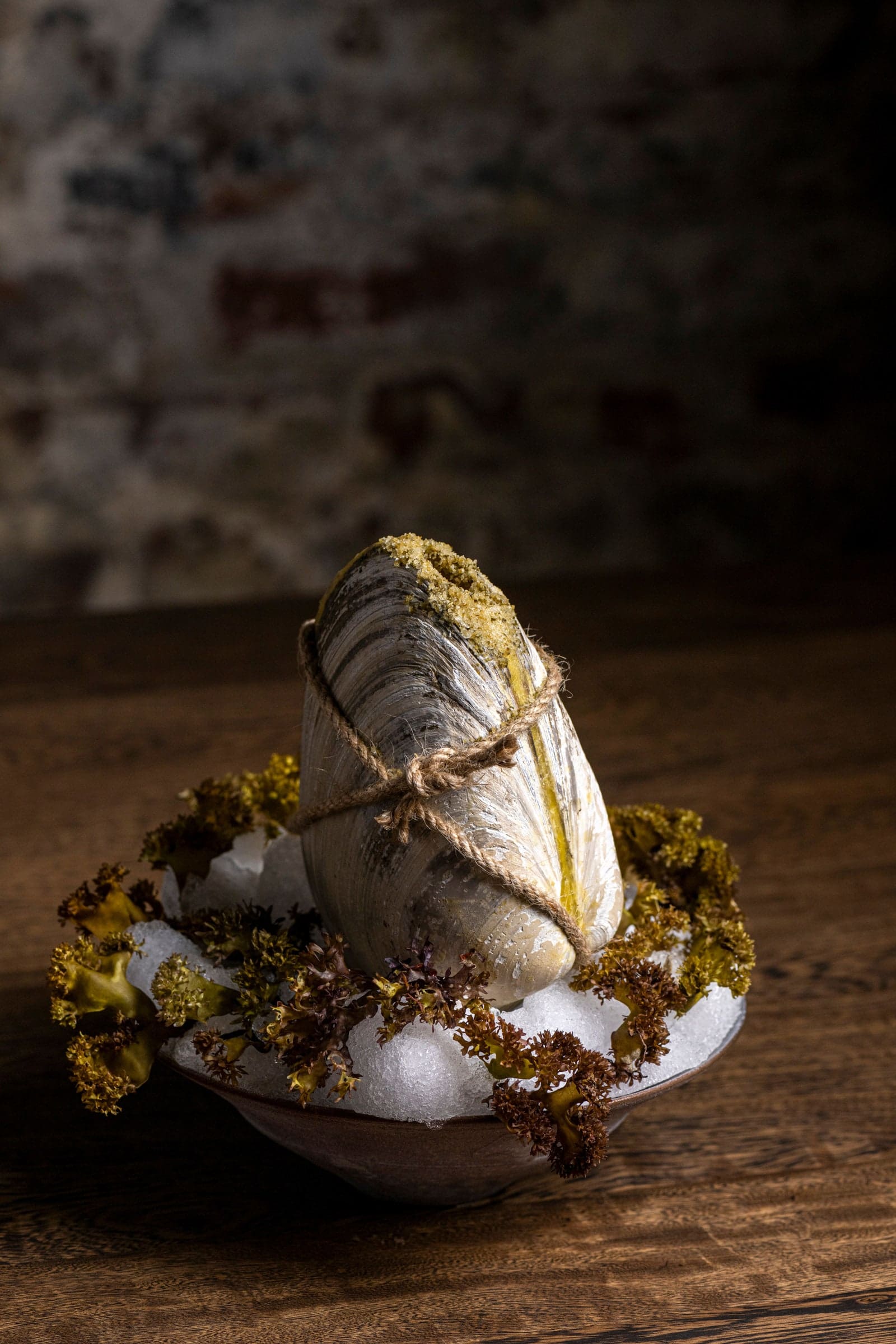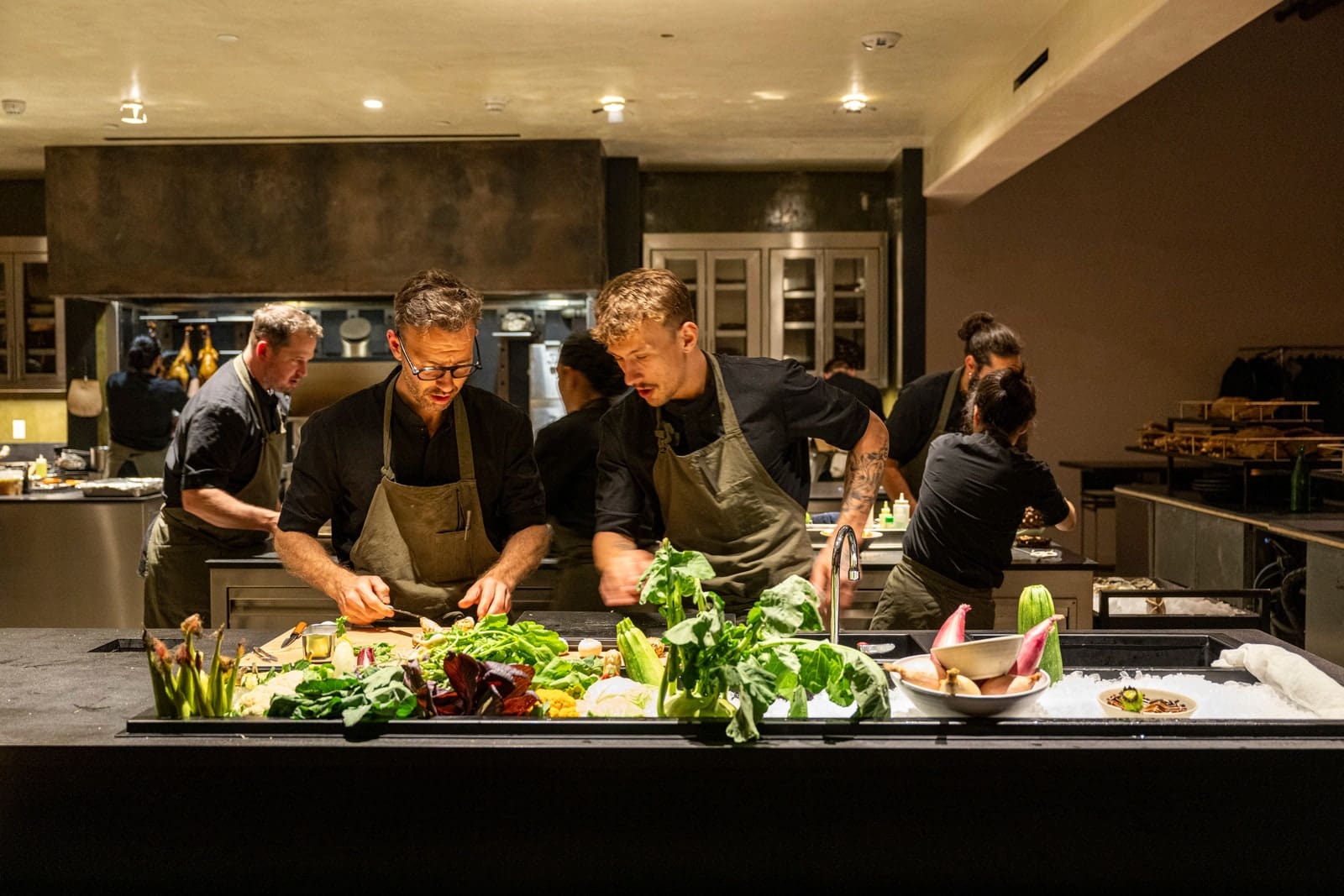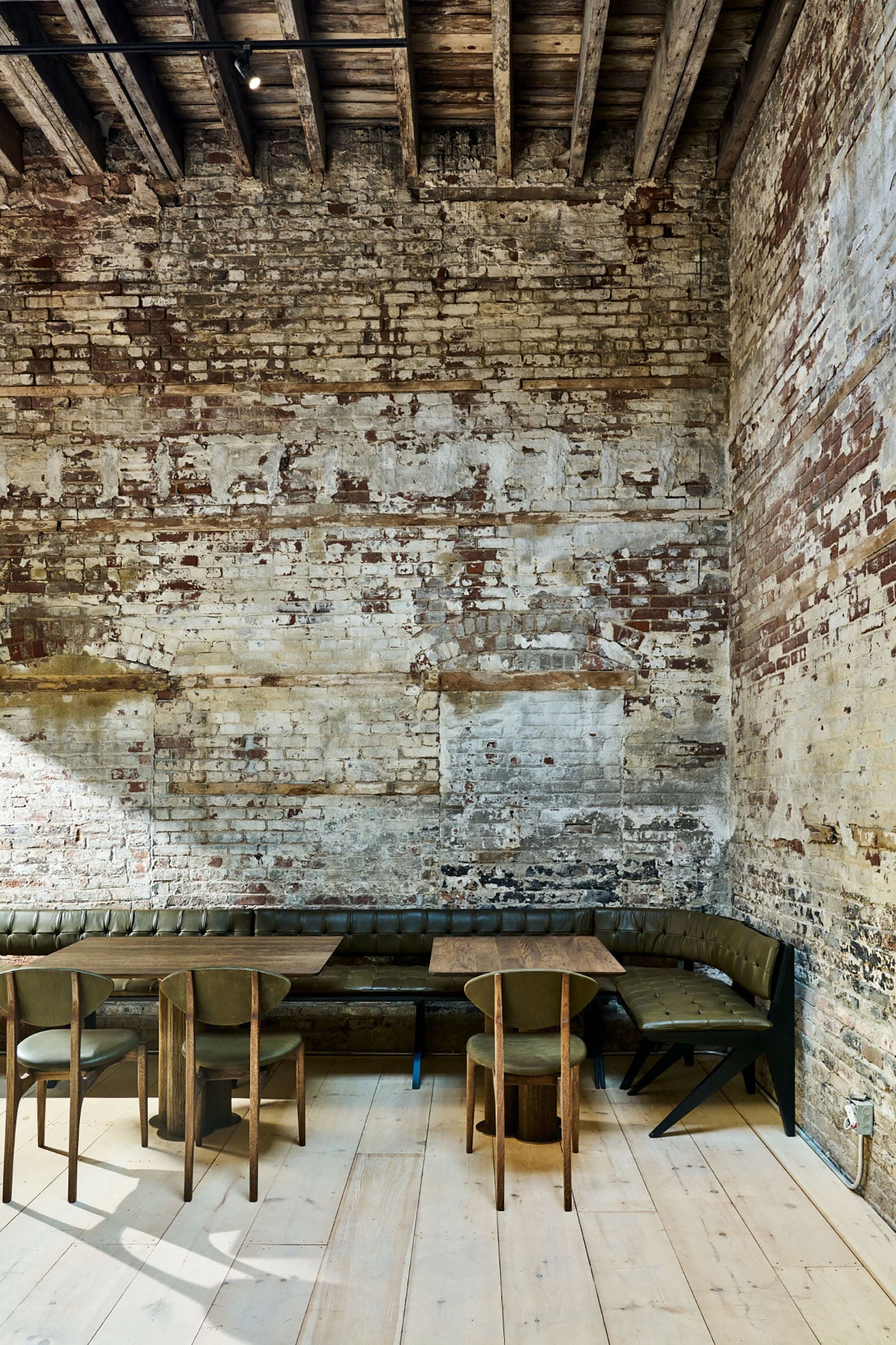Courtesy of Ilis
Behind a monumental black steel door in Greenpoint, Brooklyn, beyond a curtained foyer and a sculptural, oxidized metal host stand, the restaurant Ilis sprawls out for 4,500 square feet within a former rubber factory warehouse. Historic wooden rafters and a frosted corner skylight rise 17 feet above the floor, while faded white paint accents the exposed brick walls. In the midst of it all is the flurry of constant movement that defines this new culinary destination—which opened last week—from acclaimed chef and Noma co-founder Mads Refslund.
Without knowing the inner workings of every conceptual component that sets the staff into motion, Ilis could be reduced to a high-design, haute cuisine hotspot in a hip Brooklyn neighborhood. But this doesn’t quite convey what the venue intends to do for its guests—and its staff. Ilis also does not have waiters—at least in the traditional sense. “We are not just ‘front of house’ or ‘back of house,’” says Refslund. “Everyone is one house.”

As co-founder Will Douillet, a hospitality industry veteran who has worked with a roster of acclaimed restaurants including Alinea in Chicago and Atera in New York, explains further: “In terms of the service, we are working with our culinary team, our cooks, and our chefs, to provide all aspects of the experience.” This means that the cooks preparing the food are also those interfacing with guests about what’s on their plate, with their firsthand knowledge of each ingredient bringing the dishes to vivid life. “As Mads always says, this is a restaurant built on ideas,” explains Douillet.
It all begins with the name, an amalgam of “Il” and “Is,” or fire and ice in Danish. “I am in love with this contrast—fire and ice. It’s a formula as to how we use the ingredients,” Refslund says. “I love cooking with fire. There’s something inside of me that switches on when I smell wood burning. I immediately become creative.” At the opening night dinner, the open flames imparted a smoky flavor to everything from a tender barbecued eel, served with a marigold flower still on its stem (to use as a brush to apply additional sauce), to aged wild quail with a mushroom jus (that you eat with your hands). Elsewhere, sushi-grade scallops were served with citrus pieces and anise hyssop—but at Ilis, “ice” isn’t just about the seafood. Just take Refslund’s bison tartare: partitioned in a fresh beet wrapper, and served with housemade berry vinegar, hazelnut oil, and hibiscus.

Unlike many other fine dining establishments, Ilis does not serve a tasting menu. Rather, after guests are greeted by a host, they tour the open kitchen and its four stations (two dedicated to fire and two to ice) and are shown the night’s primary ingredients. They are then seated and offered a field guide that outlines potential outcomes for their forthcoming adventure. “The menu is built from maybe 10 or 12 ingredients each day,” Refslund says. From there, the experience is a la carte (with a minimum commitment of five courses). The chosen primary ingredient is woven throughout the meal, manifesting in various ways—and, of course, incorporating both fire and ice.
The Ilis team sources from across North America, with an emphasis on the hyper-local. “If something originates from around here, we will use it,” says Refslund. “All vegetables, all foraged things, all mushrooms are coming from here. All herbs, as well. Our seafood is coming mostly from Maine, and some from Massachusetts.” For meat, Refslund is only serving bison and venison, because of his belief that anything they serve should be free-range; as such, they are sourcing from farms like Broken Arrow Ranch in Texas.
Adding to these seasonal components are ingredients from Refslund’s vast pantry. “We started making misos and garums and soy sauce two years ago,” he says. “At the end of last summer, we started pickles and syrups and vinegars. This summer we pickled again. We have a library of flavors. It’s a whole wall that we can pick from.” Some of these pantry creations are visible during service so that guests can see how they are incorporated; as their dinner commences, they can request specific additions from the pantry, or simply turn over the creativity to the team of cooks.

Ilis also features a series of roving carts with snacks, bountiful in nature, from seafood towers to vegetable baskets—and once again, guests can select what they want from each. During our dinner, snacks were highly conceptual, from a clam broth and tomato water blend, served inside of a surf clam shell that had been transformed into a drinking vessel with beeswax, to a moon snail served with a spoon crafted from a snail shell. (These arrived with two oysters—one accompanied by a pineapple wedge in place of lemon, another with almond and cucumber melon slivers.)
The Ilis team—and in particular Refslund and chef Kane Sorrells, who heads up research and development—hopes to avoid repeat dishes on the menu. As a result, an immense amount of creativity infuses each dish, every day. Almost every seat in the restaurant faces the open kitchen and the buzzing activity within it—but sitting at the chef’s table is a cinematic experience in and of itself. “The idea of this place is not that of a restaurant, it’s a kitchen,” Refslund says. “You are sitting inside of this kitchen. You feel like you are in a kitchen. You feel the energy of it. The sounds are part of the experience. You are part of the experience.”

In many ways, each course is more like an act in a play, with the staff performing a role in which everything is visible, always. “There are a lot of little steps of service that we pulled out of the experience with intention, utilizing high design and beautiful objects, for a creative and sustainable culture,” Douillet adds, nodding to a console at a table that houses all the cutlery a person will need throughout their meal.
Meanwhile, Refslund and Douillet worked with designer Grant Blakeslee and acclaimed furniture designer Alexander Diaz Andersson, the founder of Atra Form in Mexico City, to bring their expansive vision to life. Diaz Andersson and Blakeslee also envisioned the restaurant’s “cloud,” a soft-cornered square that lowers the ceiling space over the kitchen and defines its borders. It acts as an aesthetic crown over the active food prep spaces—and even locks in excess sound.

From the charming glassware by Downtown Brooklyn-based glassblower William Couig to the impeccable uniforms by Danish designer Camilla Staerk, who also contributed the rugs and low-slung lamps, the devil is in the details. This includes the artwork adorning the walls, on loan from the neighboring contemporary art gallery, Faurschou: A large-scale figurative painting by German artist Georg Baselitz stretches across the back wall, while an original Ai Weiwei work, composed of painted Legos and featuring the face of a rat, gazes toward a vivid rooster portrait by the Ohio-based artist Zachary Armstrong.
Refslund and Douillet signed the lease for this location in October 2020, meaning it’s taken three years to bring to life. But today, the energy and eagerness of the staff speak to the vast amount of preparation, consideration, and care. “Know that when you come here, you are part of something bigger than a restaurant,” Refslund says. “Come with an open heart and an open mind—and be hungry.”
This article was originally published on Vogue.com
